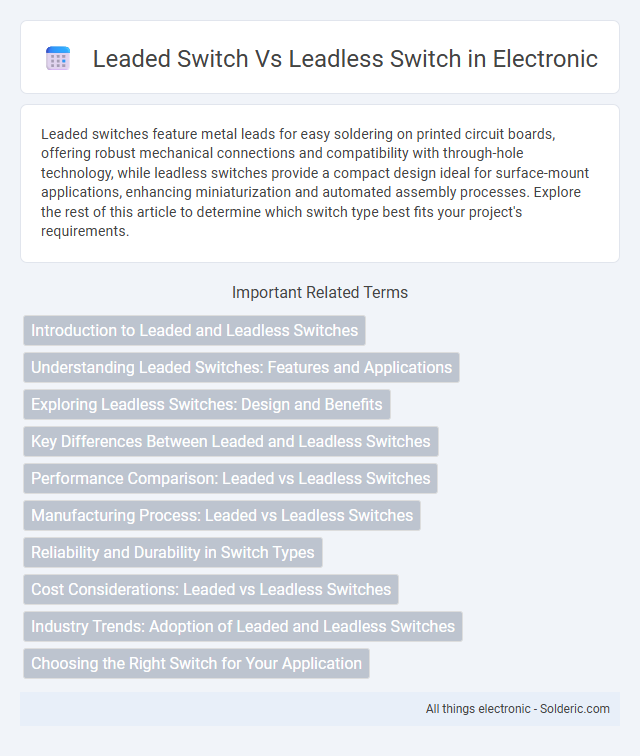Leaded switches feature metal leads for easy soldering on printed circuit boards, offering robust mechanical connections and compatibility with through-hole technology, while leadless switches provide a compact design ideal for surface-mount applications, enhancing miniaturization and automated assembly processes. Explore the rest of this article to determine which switch type best fits your project's requirements.
Comparison Table
| Feature | Leaded Switch | Leadless Switch |
|---|---|---|
| Mounting Type | Through-hole | Surface-mount |
| Size | Larger | Compact, smaller footprint |
| Installation | Manual or wave soldering | Automated pick-and-place, reflow soldering |
| Durability | Higher mechanical strength due to leads | Less mechanical stress tolerance |
| PCB Space | Consumes more PCB area | Optimizes PCB space usage |
| Cost | Generally lower component cost | Higher cost due to advanced packaging |
| Applications | Prototyping, through-hole designs, higher mechanical stress environments | High-density, compact electronics, automated assembly |
Introduction to Leaded and Leadless Switches
Leaded switches feature metal leads extending from the switch body, enabling easy through-hole PCB mounting and reliable electrical connections, commonly used in applications requiring secure mechanical stability. Leadless switches lack protruding leads and utilize surface-mount technology (SMT), providing compact design benefits and enhanced performance in miniaturized electronic devices. The choice between leaded and leadless switches depends on factors such as PCB design, space constraints, and assembly methods in electronic manufacturing.
Understanding Leaded Switches: Features and Applications
Leaded switches feature metal leads extending from the switch body, enabling easy through-hole PCB mounting and robust mechanical connection. These switches are commonly used in applications requiring secure soldering and high durability, such as industrial control systems and automotive electronics. Their design facilitates straightforward assembly and reliable performance in harsh environments.
Exploring Leadless Switches: Design and Benefits
Leadless switches feature a compact design with soldering pads instead of traditional leads, enabling efficient surface-mount technology (SMT) assembly and higher density circuit layouts. Their reduced parasitic inductance and capacitance improve high-frequency performance, making them ideal for modern electronics. The absence of protruding leads minimizes mechanical stress and enhances reliability in compact, vibration-prone applications.
Key Differences Between Leaded and Leadless Switches
Leaded switches include metal leads for through-hole PCB mounting, offering easy manual soldering and reliable mechanical stability. Leadless switches, designed for surface mount technology (SMT), lack protruding leads and require precise placement, enabling more compact circuit board layouts and higher component density. The choice between leaded and leadless switches impacts assembly process, footprint size, and suitability for automated manufacturing systems.
Performance Comparison: Leaded vs Leadless Switches
Leaded switches exhibit superior mechanical stability and easier soldering processes, resulting in enhanced electrical performance under high-stress conditions compared to leadless switches. Leadless switches offer a more compact design and improved heat dissipation, which contributes to reduced signal interference and increased reliability in miniaturized electronic assemblies. Performance metrics such as contact resistance and durability show leaded switches perform better in harsh environments, while leadless switches excel in applications demanding space-saving and thermal efficiency.
Manufacturing Process: Leaded vs Leadless Switches
Leaded switches involve attaching metal leads through holes in the PCB, requiring wave soldering or manual soldering during manufacturing, which can increase assembly time and costs. Leadless switches, designed for surface-mount technology (SMT), use flat terminals directly soldered onto the PCB surface, enabling faster automated assembly and improved reliability. Choosing between leaded and leadless switches impacts your manufacturing efficiency, cost, and product compactness.
Reliability and Durability in Switch Types
Leaded switches typically offer higher mechanical reliability due to robust solder joints and strong physical connections, reducing the risk of failure under stress or vibration. Leadless switches, while more compact and suitable for automated assembly, may experience decreased durability in harsh environments because their contacts rely on surface-mount technology, which can be more susceptible to damage or corrosion. Selecting between leaded and leadless switches involves balancing long-term reliability needs against space constraints and manufacturing processes.
Cost Considerations: Leaded vs Leadless Switches
Leaded switches generally incur higher manufacturing and assembly costs due to additional labor and materials required for lead attachment and soldering. Leadless switches offer cost advantages by simplifying PCB design and enabling automated surface-mount assembly, reducing labor and production time. However, the initial setup for leadless technology can be more expensive, potentially balancing out savings in large-scale manufacturing.
Industry Trends: Adoption of Leaded and Leadless Switches
Industry trends reveal a growing preference for leadless switches due to their compact design, enhanced reliability, and improved suitability for automated assembly processes in consumer electronics and automotive sectors. Leaded switches still maintain relevance in applications requiring easy manual soldering and prototyping, particularly in industrial equipment and legacy systems. Your choice between leaded and leadless switches should consider production scale, assembly methods, and long-term durability requirements.
Choosing the Right Switch for Your Application
Selecting the appropriate switch depends on factors like space constraints, durability, and electrical requirements. Leaded switches offer easier soldering and mechanical stability for prototype and repair applications, while leadless switches provide a compact profile ideal for high-density circuits and automated assembly. Understanding your project's size limits, current capacity, and mounting process ensures optimal switch performance and reliability.
leaded switch vs leadless switch Infographic

 solderic.com
solderic.com